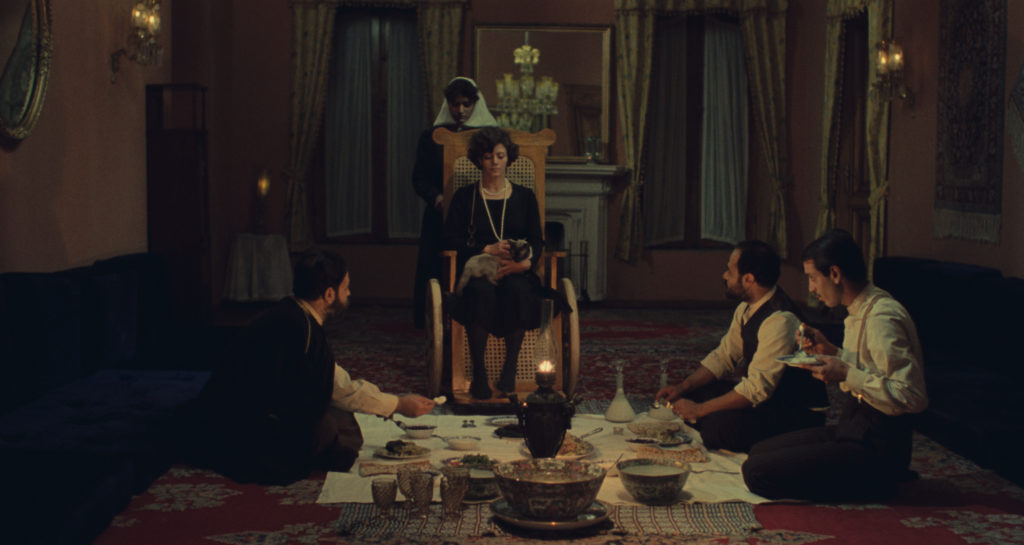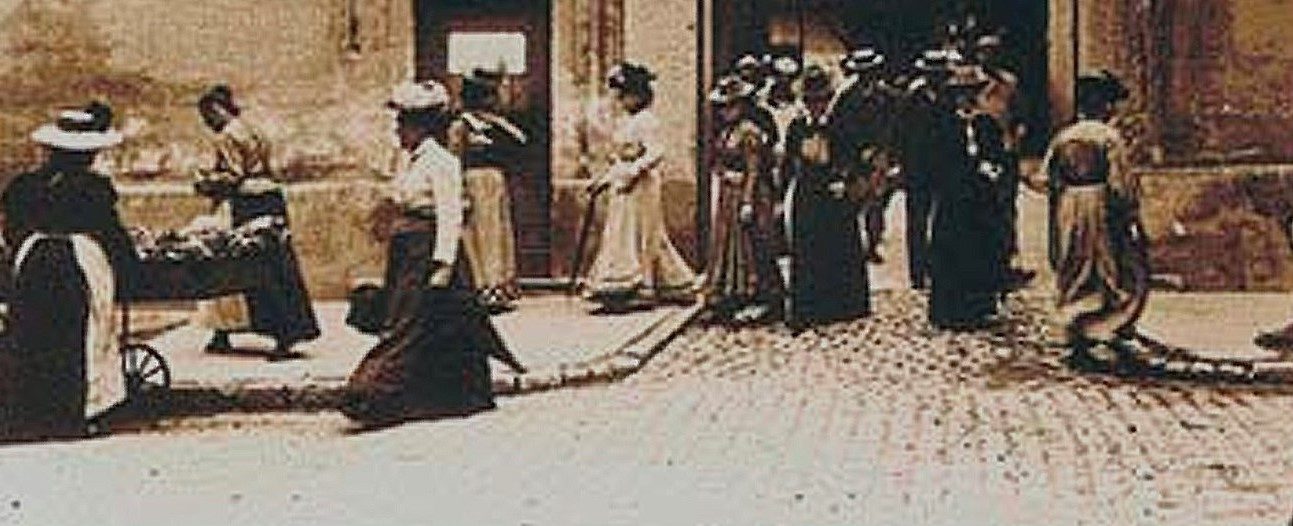Iran, 1976
Directed by Mohammad Reza Aslani
With Fakhri Khorvash (Little Lady), Shohreh Aghdashlou (Kanizak), Mohammad Ali Keshavarz (Haji Amou), Akbar Zanjanpour (Ramazan), Shahram Golchin (Shaban)

There is the house and there is the world. Neither ignores the other, or stands completely cut off from the other: the handmaidens of the house walk to a public fountain where other maids of the wealthy Tehran neighborhood where the action takes place gather to do the laundry, and professionals readily enter the house whenever they are needed: a notary, a policeman, a doctor. Whatever is or may be going on in the house is the source of gossips and comments at the maids’ gatherings. Their scenes cast them as a kind of ancient Greek chorus helping the audience to get enough clues about the lead characters’ past and present; always starting with a long shot, the camera slowly zooms in, highlighting the gestures and the faces of the maids, a visual motif that is also evidence that those on the bottom of the social ladder are aware of what those standing on the upper rungs are up to. How useful the outside world can be and also what kind of pressure it is never escapes the mind of the rich people living in the house (as they need tools to pursue their schemes and dreams of opportunities to get richer in what is a changing economy).
Yet a distance does exist, emphasized by light. Many outside scenes occur in the broad daylight, often under a sunny sky, though wind and clouds can spoil the day, while many inside scenes, though not all, are lighted only by the many candles fixed to on walls or set in chandeliers. Ordinary life exploding in the streets is one thing, the lavish life contained in the house is definitely another: the house inhabitants follow their own instincts and rules, perverted by greed and selfishness. However, in the final scene, the two worlds would get connected, the house delivering to the streets the woman who tricked the rules of her masters, only to walk away like an enigma. It is true that at this point, those who dominated the house are no more.
In the dim and stifling vast rooms, long corridors, and impressive, elegant, and central (architecturally and narratively) stairway of the house the lead characters spy each other and reckon how they could attack. Far from looking like the traditional and ideal image of a tight-knit and loving family the relatives living in the house are busy hating each other and plotting against each other. This is not a love nest, it is a snake pit. The bluntest of the group is the patriarch wielding money and power, and above all wits and deeds – he is first shot while dealing with a notary. A goldsmith and a fearsome bulky fellow, Haji Amou, literally in Farsi the believer who made the pilgrimage to the Mecca (and this is ironic given how unholy his actions and thoughts are), is a widower who grudges the presence of his late wife’s adult daughter, Little Lady. He barely bears the presence of two nephews who assist him in his failing business, Ramazan, who is as stout and stubborn as his uncle and hopes to marry Little Lady, and Shaban, a thinner, younger, fickler fellow who flirts with Little Lady’s nice-looking, precious, and loyal handmaiden – the meaning of the word Kanizak, her first name. Lady Lady cuts quite a fascinating figure, suffering from a flawed body – she is wheelchair-bound, needs a monocle, and gets often sick – but ruled by a sharp and determined mind; still mourning her mother she expects to inherit from her.
The film quickly shows how fiercely Haji Amou despises his relatives and how strongly he enjoys lording it over them. The nephews chafe but the stepdaughter dares to go a step further and tries to push Haji Amou off his pedestal. Helped by Kanizak, she works to undermine his position, burning deeds first and then, deeming more is needed, killing him. The depressing depiction of hatred gives way to a graphic crime story.
Haji Amou’s disappearance means the world comes to the house: creditors and a police commissar wonder about his whereabouts. The house undergoes changes: Ramazan behaves as the new patriarch and it is not clear what Little Lady is to gain from the situation she created – hatred and distrust, stirred by greed and selfishness, still prevail. But then the film’s narrative borrow the logic of another movie genre. It seems everybody has noticed the presence of Haji Amou in the outside world. So is he really dead? Little Lady cannot doubt and yet is at a loss. Tension, of a fresh kind, far more unsettling to her and to the audience than what the film’s first part held, rises till one decisive night. The film’s cinematography is radically altered and the disturbing images refer to horror flicks, especially from the silent era. And it is with genuine horror that Little Lady finds out the truth about Haji Amou and Kanizak. The patriarch is once again killed, with the expected outcome this time reached, but his nemesis suffers from a heart attack and dies too.
Dynamics change again and then again not: two of the wealthy relatives are out of the picture but the two others would also fight each other, as greed and selfishness keep taking a toll (shaped by differing views on how to ride on the coattails of the modernizing economy and by jealousy). Another kind of horror, sheer insanity driving men of the same blood to destroy themselves, bloodies and darkens the dim corridors. The wealthy gone one way or another, only the domestics remain, including the young woman who betrayed in fact everybody. And it is Kanizak who leaves unscathed to an uncertain future, trusting the whole estate to a young boy as if she was the real owner.
What an amazing and baffling finale, raising many questions. Is double-crossing the only way in the world? But is it not fair that Kanizak tries her luck outside after being not always a conscious and diligent helper but also a person men liked mainly out of naked desire? But then why did she betray a mistress who harbored more than sympathetic feelings for her, in fact clearly having sexual desire for her? The most stunning and shocking element of this family drama is indeed how much sexuality plays a part in the relations between the characters and how it inspires them, especially Kanizak, to make scandalous, destructive moves – and homosexuality is as much involved as heterosexuality. Still, the main reason for action remains money and the social status it helps to create or to sustain – that is probably the limit the ambition or reverie of Kanizak were doomed to bump against: Shaban is quite honest when he tells her that of course her origin and status would always keep her in the background. But the irony is that the race to get a bigger fortune and a higher status ends up for these perverted members of the financial elite in an apocalypse.
The film is a moral tale and actually claimed to be such as soon as it began, with a title card and a stern voice presenting the audience with the contents of the Quran’s 102nd surah – “The mutual rivalry for piling up (the good things of this world) diverts you (from the more serious things) / Until ye visit the graves” to quote the first lines. It does not mean it is a pious work: no edifying, inspirational figure truly stands out of the grim story. The film candidly observes vices, embracing the most problematic and scandalous aspects of humanity without expressing righteousness. And it eschews the clarity and simplicity of the moral fable, tinkering instead with various genre tropes and using graciously cameras and cinematography to create surprise and to stir emotions, even the most upsetting ones. There is passionate interest and self-evident pleasure in delicately crafting an elaborate and elegant work of art, with nods to various pictorial traditions, challenging expectations of traditional, simplistic narratives and narrations.
Set in the 1920s Tehran, as the power of the Qajar dynasty, reigning since 1789, collapses, the story is a damning indictment of an elite living away and above the society, obsessed with their own, sordid interests. This house and this world are depressingly separated by an unfair gap in wealth, attitudes, purposes. But it could be director Mohammad Reza Aslani’s point is even broader as he shoots his film at a time when the political power is rushing to make a mostly rural and conservative society a modern nation aligned with Western ideas of power and wealth, while clinging to a vertical, hierarchical, discriminatory social structure – and indeed the final images are a panoramic view of the 1976 Tehran. Whether in the 1970s, or the 1920s, or obviously far earlier in Iran’s long history, Iran is a society undermined by inequity with the thirst for prestige, money, and personal interests putting those on the top at an unbridgeable distance from the rest of the society. In this respect, a handmaiden may be entitled to do every dirty tricks to assert at long last her own interests and freedom.
This could have been more than enough to drive the Iranian elite in 1976 to prevent “Shatranj-e baad – Chess of the Wind” from reaching the movie theaters. And its portrayal of irreligious attitudes would provide enough reasons for the Islamic Republic government born from the 1979 revolution to keep it under wraps. Anyway, its obvious and compelling artistic ambitions set it too apart from what movies productions in Iran offered and local moviegoers expected. The film was doomed and it was thought to be lost when reels resurfaced later, in the 2010s, allowing it, after being restored, to have a new lease of life.

